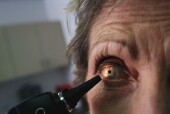
THURSDAY, Nov. 18 (HealthDay News) — Cataract surgery, already an extremely safe and successful procedure, can be made more precise by combining a laser and three-dimensional imaging, a new study suggests.
Researchers found that a femtosecond laser, used for many years in LASIK surgery, can cut into delicate eye tissue more cleanly and accurately than manual cataract surgery, which is performed more than 1.5 million times each year in the United States.
In the current procedure, which has a 98 percent success rate, surgeons use a micro-blade to cut a circle around the cornea before extracting the cataract with an ultrasound machine. The laser procedure uses optical coherence technology to customize each patient’s eye measurements before slicing through the lens capsule and cataract, though ultrasound is still used to remove the cataract itself.
“It takes some skill and energy to break the lens with the ultrasound,” explained lead researcher Daniel Palanker, an associate professor of ophthalmology at Stanford University. “The laser helps to speed this up and make it safer.”
After practicing the laser procedure on pig eyes and donated human eyes, Palanker and his colleagues did further experiments to confirm that the high-powered, rapid-pulse laser would not cause retinal damage.
Actual surgeries later performed on 50 patients between the ages of 55 and 80 showed that the laser cut circles in lens capsules 12 times more precise than those achieved by the traditional method. No adverse effects were reported.
The study, reported in the Nov. 17 issue of Science Translational Medicine, was funded by OpticaMedica Corp. of Santa Clara, Calif., in which Palanker has an equity stake. The results are being reviewed by the U.S. Food and Drug Administration, while the laser technology, which is being developed by several private companies, is expected to be released worldwide in 2011.
Dr. Scott Greenstein, a comprehensive ophthalmology and cataracts expert at Massachusetts Eye and Ear Infirmary, said he was uneasy that the research was funded by a company with a stake in the outcome. But he added that the data was encouraging.
“I personally am excited by it,” said Greenstein, who teaches ophthalmology at Harvard Medical School. “It’s an enhancement of something we’re already doing that’s quite successful.”
“We need a number of centers studying this with more patients,” he added. “It would be useful to see if there is a significant statistical difference in the outcomes.”
Both Greenstein and Dr. Richard Bensinger, a Seattle ophthalmologist and spokesman for the American Academy of Ophthalmology, expressed concern that the laser-guided cataract surgery would be much more expensive than manual surgery and were skeptical that health insurance companies would be willing to pick up the tab.
“It’s a fairly expensive way to do something we do right now with a $120 instrument that makes the opening,” Bensinger said. “It’s beneficial to the extent that it can avoid a tear [in the cornea] . . . but the downside is you need a very expensive machine to do it. It’s at best a little refinement that adds a little precision.”
Although the femtosecond laser technique is unquestionably more precise, Palanker’s claim that it results in a better fit for the artificial lens replacing the clouded one is dubious, Bensinger and Greenstein said. Experienced surgeons performing manual cataract surgery rarely have trouble aligning the new lens with the pupil and keeping it in place, they noted.
“Over the thousands of cases I’ve done, I’m really not aware personally of this being a problem,” Greenstein said. “If you have a less precise, experienced surgeon then this would be a benefit for the patient. It makes reproducible, perfect incisions every time.”
Palanker said further research will focus on whether laser-guided cataract surgery results in better postoperative vision than traditional surgery. Among the small group of study participants, he said, there was no significant difference in outcomes between the two.
More information
Find out more about cataracts at the U.S. National Eye Institute.

